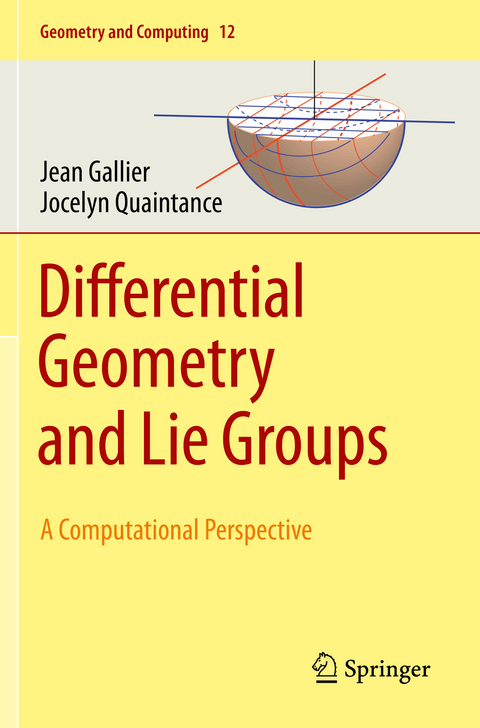
Differential Geometry and Lie Groups
Springer International Publishing (Verlag)
978-3-030-46042-6 (ISBN)
This textbook offers an introduction to differential geometry designed for readers interested in modern geometry processing. Working from basic undergraduate prerequisites, the authors develop manifold theory and Lie groups from scratch; fundamental topics in Riemannian geometry follow, culminating in the theory that underpins manifold optimization techniques. Students and professionals working in computer vision, robotics, and machine learning will appreciate this pathway into the mathematical concepts behind many modern applications.
Starting with the matrix exponential, the text begins with an introduction to Lie groups and group actions. Manifolds, tangent spaces, and cotangent spaces follow; a chapter on the construction of manifolds from gluing data is particularly relevant to the reconstruction of surfaces from 3D meshes. Vector fields and basic point-set topology bridge into the second part of the book, which focuses on Riemannian geometry.
Chapters on Riemannian manifolds encompass Riemannian metrics, geodesics, and curvature. Topics that follow include submersions, curvature on Lie groups, and the Log-Euclidean framework. The final chapter highlights naturally reductive homogeneous manifolds and symmetric spaces, revealing the machinery needed to generalize important optimization techniques to Riemannian manifolds. Exercises are included throughout, along with optional sections that delve into more theoretical topics.
Differential Geometry and Lie Groups: A Computational Perspective offers a uniquely accessible perspective on differential geometry for those interested in the theory behind modern computing applications. Equally suited to classroom use or independent study, the text will appeal to students and professionals alike; only a background in calculus and linear algebra is assumed. Readers looking to continue on to more advanced topics will appreciate the authors' companion volume Differential Geometry and Lie Groups: A Second Course.
lt;b>Jean Gallier is Professor of Computer and Information Science at the University of Pennsylvania, Philadelphia. His research interests include geometry and its applications, geometric modeling, and differential geometry. He is also a member of the University of Pennsylvania's Department of Mathematics, and its Center for Human Modelling and Simulation.
Jocelyn Quaintance is postdoctoral researcher at the University of Pennsylvania who has contributed to the fields of combinatorial identities and power product expansions. Her recent mathematical books investigate the interplay between mathematics and computer science. Covering areas as diverse as differential geometry, linear algebra, optimization theory, and Fourier analysis, her writing illuminates the mathematics behind topics relevant to engineering, computer vision, and robotics.
1. The Matrix Exponential; Some Matrix Lie Groups.- 2. Adjoint Representations and the Derivative of exp.- 3. Introduction to Manifolds and Lie Groups.- 4. Groups and Group Actions.- 5. The Lorentz Groups .- 6. The Structure of O(p,q) and SO(p, q).- 7. Manifolds, Tangent Spaces, Cotangent Spaces.- 8. Construction of Manifolds From Gluing Data .- 9. Vector Fields, Integral Curves, Flows.- 10. Partitions of Unity, Covering Maps .- 11. Basic Analysis: Review of Series and Derivatives.- 12. A Review of Point Set Topology.-13. Riemannian Metrics, Riemannian Manifolds.- 14. Connections on Manifolds.- 15. Geodesics on Riemannian Manifolds.- 16. Curvature in Riemannian Manifolds.- 17. Isometries, Submersions, Killing Vector Fields.- 18. Lie Groups, Lie Algebra, Exponential Map.- 19. The Derivative of exp and Dynkin's Formula .- 20. Metrics, Connections, and Curvature of Lie Groups.- 21. The Log-Euclidean Framework.- 22. Manifolds Arising from Group Actions.
"The book ... is intended 'for a wide audience ranging from upper undergraduate to advanced graduate students in mathematics, physics, and more broadly engineering students, especially in computer science.' ... The text's coverage is extensive, its exposition clear throughout, and the color illustrations helpful. The authors are also familiar with many texts at a comparable level and have drawn on them in several places to include some of the most insightful proofs already in the literature." (Jer-Chin Chuang, MAA Reviews, October 4, 2021)
"The book is intended for incremental study and covers both basic concepts and more advanced ones. The former are thoroughly supported with theory and examples, and the latter are backed up with extensive reading lists and references. ... Thanks to its design and approach style this is a timely and much needed addition that enables interdisciplinary bridges and the discovery of new applications for differential geometry." (Corina Mohorian, zbMATH 1453.53001, 2021)
| Erscheinungsdatum | 18.08.2021 |
|---|---|
| Reihe/Serie | Geometry and Computing |
| Zusatzinfo | XV, 777 p. 33 illus., 32 illus. in color. |
| Verlagsort | Cham |
| Sprache | englisch |
| Maße | 155 x 235 mm |
| Gewicht | 1329 g |
| Themenwelt | Mathematik / Informatik ► Mathematik ► Analysis |
| Mathematik / Informatik ► Mathematik ► Geometrie / Topologie | |
| Schlagworte | adjoint representation • Connections on real manifolds • differential geometry for computer vision • Differential geometry for computing • differential geometry for geometry processing • differential geometry for machine learning • differential geometry for robotics • differential geometry textbook • grassmannian manifold • homogeneous spaces • lie algebras for computing • Lie Brackets • linear lie groups • Lorentz groups • matrix exponential • matrix Lie groups • Riemannian manifold • Riemannian manifold curvature • stiefel manifold • Theory of manifold optimization techniques |
| ISBN-10 | 3-030-46042-8 / 3030460428 |
| ISBN-13 | 978-3-030-46042-6 / 9783030460426 |
| Zustand | Neuware |
| Haben Sie eine Frage zum Produkt? |
aus dem Bereich


